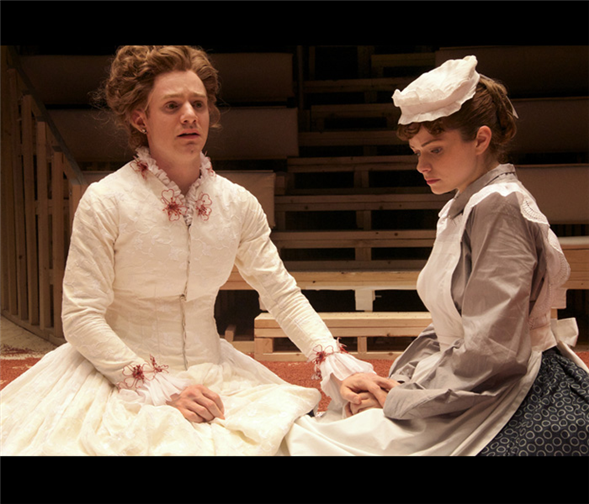Translate Page

It helps, of course, that the play is so stimulating. The first act takes place in colonial Africa in the 19th century, where Martin, a British administrator, lives with his family and tries his best to uphold his country's ideals. These include the presumed superiority of straight, white men, and that perception is ingrained so strongly that Betty (Martin's wife) is played by a male actor in drag, Joshua (Martin's African servant) is played by a white man, and Victoria (Martin's daughter) is just a doll. The implication is that colonialism has warped these people so much that their very cells are trying to honor the patriarchy.
Act II, however, is radically different. Set in 1979, it features many of the same characters from before, except they've only aged a few years while the world itself has rocketed forward by a century. The sexual revolution has replaced colonial oppression, and those who were struggling to know themselves are experiencing their bodies and their minds with a bracing new clarity.
So… if you're working on Cloud Nine, how do you decide what all this looks like? Both costume designer Gabriel Berry and set designer Dane Laffrey say it helps to leave literalism at the door.
"In reading and rereading it and talking with [director] James [Macdonald] and Caryl, I couldn't imagine how it looked," Laffrey says. "I could only imagine how it felt, in terms of how people needed to move through the play."
To that end, he's created more of an immersive environment than a typical set. When we enter the theatre, we find a large coliseum made of unfinished wood. We all sit on benches that are all built into the structure, and the actors not only perform on the floor in the center, but also use entrances and exits that take them through the crowd. "It has a lot to do with the vom structure and how it propels action," Laffrey says, and he's right. His design makes us feel like we've been dropped into the middle of an event that's happening, urgently, all around us.
{Image1}
He adds that his approach reflects the energy of the script. "The main goal of the design was to propel people without imposing architecture on the play," he says. "This plays defies architecture in the extreme, since 90 percent of it takes place outside. Adding some kind of structure on top of it would make some kind of overarching statement that the play doesn't need."
Similarly, Berry doesn't want her costumes to make too much of a statement about either the colonial period or 1979. That's why she'd rather have her designs evoke archetypes than slavishly recreate times gone by. "If you actually do strict period, it gets fussy and in your face," she says. "I lived through the late 70s, and if I had actually done period costume, with all that stuff that's polyester, it would have been appalling to people. And in the first act, it's not even set in a particular place or particular time. It's just this memory of the British colonial presence in Africa."
Therefore, we see characters in frocks and pants and vests that suggest vintage attire, but actually include handmade items and pieces purchased off the rack just a few weeks ago. "I was looking for clothes; I wasn't looking for costumes," Berry says. "I was immediately alienated from anything that seemed to comment on the play."
In fact, when Churchill saw the show, her only criticism was of a dress that Victoria – now a grown woman, not a doll – wears in Act II. As Berry recalls, "She said that Victoria was looking too good. She said, 'She's a Marxist feminist, and she wouldn't be so fabulous.'" And as coincidence would have it, that dress was one of the only authentically vintage pieces left in the show. It has since been cut.
This highlights an important fact about the play: Despite when it's set, its themes are not frozen in time. "There's never any desire for me to take you back in time," Berry says, describing her own design philosophy as well as the show. "It's 2015, and what I'm doing is happening in 2015."
---
Follow Mark Blankenship at @IAmBlankenship. Follow TDF at @TDFNYC.
Photos by Doug Hamilton. Top photo: Chris Perfetti as Betty and Izzie Steele as Ellen, a governess.
TDF MEMBERS: Click here to see all of our discounted tickets to plays, musicals, concerts, and more.